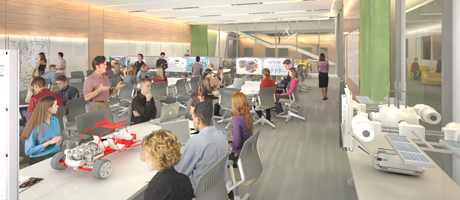Specially designed classrooms in the Science and Engineering Complex would embrace a more engaging, hands-on teaching format.
Matters of time and space are no longer just fodder for inside the science classroom; increasingly around campus, they’re topics of discussion about the classroom itself.
The issue is the distance, mentally and physically, between a traditional course lecture and its associated lab. A lecture topic might be covered in a lab experiment days afterward, or the following week; or worse, the week before.
It's a gap the university is trying to bridge, for some courses, with the new Science and Engineering Complex. A set of specialized classrooms planned for the building would offer the "complete integration of lecture and lab elements," says Gerald Feldman, a professor in the Physics Department.
"That's the whole new wave of pedagogy: that you don't have lectures where students sit and just listen to you," says Dr. Feldman. "They have to do stuff."
Current plans for the building call for several so-called studio labs for small classes and two larger teaching facilities known as scale-up labs—a concept adapted from a larger-class-size model developed at North Carolina State University. ("Scale-up" comes from the NC State project's acronym: Student-Centered Active Learning Environment for Undergraduate Programs (SCALE-UP) Project.)
Both types of rooms aim to create a dynamic atmosphere that's interactive, collaborative, and shifts learning off of the blackboard and into the hands of students.
The scale-up model for larger classes—which at GW would include up to 108 students—calls for a room of wide, circular tables each with nine students lumped into groups of three. In both the scale-up and the smaller studio format, students use computers, whiteboards and other tools and equipment (which might include things like sensors, or materials for designing a circuit) to complete exercises and solve problems lobbed at them by the instructor.
Audio/visual technology, such as large screens on the walls, would be woven into the classroom so a team's work could be seamlessly shared with the rest of the class.
The instructor, in this case, is "more like a coach," says Dr. Feldman. "You don't have your team sitting there watching a guy draw on a blackboard all day; you might have a little bit of discussion but then you go out on the field."
Teams can interact with other teams around the table, as well as with the instructor and teaching assistants making their rounds. “Some people say that in a scale-up room there’s no place to hide,” says Dr. Feldman. “Every student is reachable by the instructor.”
This style of meshing lecture and lab, though now spreading across disciplines, had been developed with physics in-mind, and the GW Physics Department plans to use one of the two scale-up labs in the new Science and Engineering Complex to host all of its large, introductory-level courses.
The other scale-up room would be used primarily by other departments from the Columbian College of Arts and Sciences residing in the new building. Built-in features would enable the room to be easily reconfigured into space with less seating or more to better suit special events, like symposia or talks by visiting scholars.
The scale-up rooms at the Science and Engineering Complex would be an outgrowth of a pilot project at GW launched in 2008, using Monroe Hall Room 111.
The room has provided "an interesting but somewhat limited pilot," says Dr. Feldman, primarily due to technology and size limitations. But it’s allowed professors to test the concept and, he says, has even garnered two research grants from the National Science Foundation to try broadening the use of the scale-up format.
The several studio labs in the new building would be utilized by individual departments to fill similar needs on a smaller scale.
The concept has already been generating interest from faculty members at GW’s School of Engineering and Applied Science, says Bhagirath Narahari, associate dean for undergraduate affairs and a computer science professor.
Engineering students likely still would need separate lab sessions in order to use bigger equipment and facilities, like the high bay planned for the new building.
But in testing the waters in recent years, the benefits have been tangible.
"The performance of the students was much better than when I taught it in the traditional setting," says Dr. Narahari of a computer science course he taught using the studio lab model. "When I gave comparable exams, the average was higher by 10 percent."
Having "the theory and practice coming together in one setting" would mean a significant shift from current instruction, he says. The heightened engagement and interaction would mean students are more challenged—and instructors might be, too.
"All of that means that students will learn better and we could push the envelope," he says.


